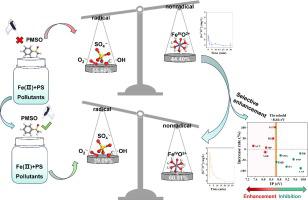当前位置:
X-MOL 学术
›
Sep. Purif. Technol.
›
论文详情
Our official English website, www.x-mol.net, welcomes your feedback! (Note: you will need to create a separate account there.)
Unexpectedly enhanced degradation of acetaminophen by sulfoxides probe in Fe(II)-activated persulfate oxidation: The mechanism and the selectivity
Separation and Purification Technology ( IF 8.6 ) Pub Date : 2024-03-19 , DOI: 10.1016/j.seppur.2024.127156 Xianni Song , Xinhua Xu , Donglei Wu , Haijiao Xie
Separation and Purification Technology ( IF 8.6 ) Pub Date : 2024-03-19 , DOI: 10.1016/j.seppur.2024.127156 Xianni Song , Xinhua Xu , Donglei Wu , Haijiao Xie

|
Sulfoxides are widely recognized as probes for identifying and evaluating the generation and contribution of high-valent metals in advanced oxidation processes. However, this paper was surprising to find that the presence of sulfoxides selectively enhanced the degradation of specific pollutants in the Fe(II)/PS system. Represented by methyl phenyl sulfoxide (PMSO), scavenging experiments for active species showed that the presence of PMSO transformed the mechanism from radical dominated (55.60 %) to nonradical dominated (60.91 %), greatly improving the anti-interference ability of the system. Determining the concentration of Fe(Ⅱ) and total iron (Fe) in solution revealed that the presence of PMSO improved the utilization efficiency of Fe(II) and PS by enhancing the redox reaction between Fe(II) and PS, and resulted in the generation of Fe(IV) more favorably than the generation of SO and ·OH. Additionally, comparing the proven high-valent iron dominated Fe(II)/PI system with the free radical dominated Fe(II)/PS system of this paper, it was revealed that the selectively enhanced oxidation of PMSO specifically targets the free radical dominated system. Experiments have shown that the degradation of acetaminophen, ibuprofen, phenol, and p-chlorophenol was enhanced by PMSO, while the degradation of norfloxacin, primidone, chloramphenicol, sulfamethoxazole, p-nitrophenol, benzoic acid, and nitrobenzene was inhibited. Based on density functional theory (DFT) calculations, PMSO has a selectively enhanced degradation effect for organic pollutants with ionization potential (IP) below 8.66 eV, and vice versa, it has an inhibitory effect. The present study provides new insights into the contribution of sulfoxide to the assessment of high-valent metals and sheds new light on the mechanism of active species.
中文翻译:

Fe(II) 激活的过硫酸盐氧化中亚砜探针意外增强了对乙酰氨基酚的降解:机理和选择性
亚砜被广泛认为是识别和评估高级氧化过程中高价金属的生成和贡献的探针。然而,本文令人惊讶地发现亚砜的存在选择性地增强了 Fe(II)/PS 系统中特定污染物的降解。以甲基苯基亚砜(PMSO)为代表的活性物种清除实验表明,PMSO的存在使机理从自由基主导(55.60%)转变为非自由基主导(60.91%),大大提高了系统的抗干扰能力。测定溶液中 Fe(II) 和总铁 (Fe) 的浓度表明,PMSO 的存在通过增强 Fe(II) 与 PS 之间的氧化还原反应,提高了 Fe(II) 和 PS 的利用效率,并导致Fe(IV)的生成比SO和·OH的生成更有利。此外,将已证实的高价铁主导的 Fe(II)/PI 体系与本文的自由基主导的 Fe(II)/PS 体系进行比较,发现 PMSO 的选择性增强氧化专门针对自由基主导的体系。实验表明,PMSO增强了对乙酰氨基酚、布洛芬、苯酚和对氯苯酚的降解,而抑制了诺氟沙星、扑米酮、氯霉素、磺胺甲恶唑、对硝基苯酚、苯甲酸和硝基苯的降解。基于密度泛函理论(DFT)计算,PMSO对电离势(IP)低于8.66 eV的有机污染物具有选择性增强的降解作用,反之则具有抑制作用。本研究提供了关于亚砜对高价金属评估的贡献的新见解,并为活性物质的机制提供了新的线索。
更新日期:2024-03-19
中文翻译:

Fe(II) 激活的过硫酸盐氧化中亚砜探针意外增强了对乙酰氨基酚的降解:机理和选择性
亚砜被广泛认为是识别和评估高级氧化过程中高价金属的生成和贡献的探针。然而,本文令人惊讶地发现亚砜的存在选择性地增强了 Fe(II)/PS 系统中特定污染物的降解。以甲基苯基亚砜(PMSO)为代表的活性物种清除实验表明,PMSO的存在使机理从自由基主导(55.60%)转变为非自由基主导(60.91%),大大提高了系统的抗干扰能力。测定溶液中 Fe(II) 和总铁 (Fe) 的浓度表明,PMSO 的存在通过增强 Fe(II) 与 PS 之间的氧化还原反应,提高了 Fe(II) 和 PS 的利用效率,并导致Fe(IV)的生成比SO和·OH的生成更有利。此外,将已证实的高价铁主导的 Fe(II)/PI 体系与本文的自由基主导的 Fe(II)/PS 体系进行比较,发现 PMSO 的选择性增强氧化专门针对自由基主导的体系。实验表明,PMSO增强了对乙酰氨基酚、布洛芬、苯酚和对氯苯酚的降解,而抑制了诺氟沙星、扑米酮、氯霉素、磺胺甲恶唑、对硝基苯酚、苯甲酸和硝基苯的降解。基于密度泛函理论(DFT)计算,PMSO对电离势(IP)低于8.66 eV的有机污染物具有选择性增强的降解作用,反之则具有抑制作用。本研究提供了关于亚砜对高价金属评估的贡献的新见解,并为活性物质的机制提供了新的线索。



























 京公网安备 11010802027423号
京公网安备 11010802027423号